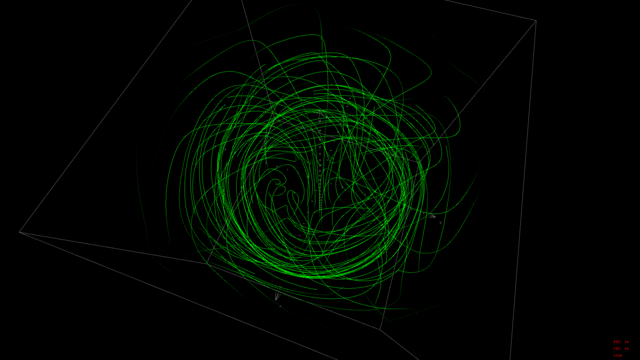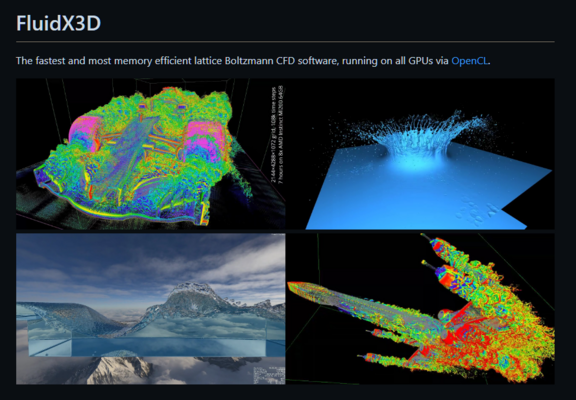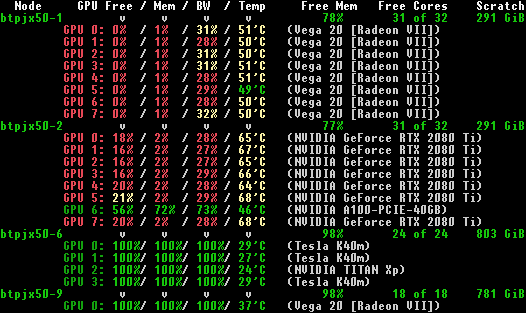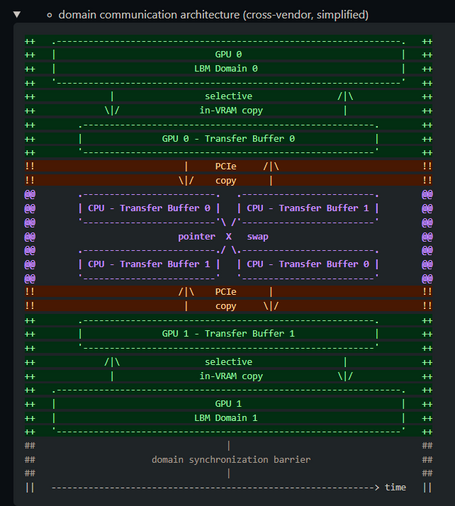Pekka Jääskeläinen · @pekka
28 followers · 34 posts · Server fosstodon.org@ProjectPhysX Good choice! We were just in the morning discussing with Jan and wondering what happened to the #fluidx3d patches you made in Spring to improve its multi-node scaling with PoCL-R. Any plans with that you can share?
Dr. Moritz Lehmann · @ProjectPhysX
233 followers · 81 posts · Server mast.hpc.socialOver the weekend I got to test #FluidX3D on the world's largest #HPC #GPU server, #GigaIOSuperNODE. Here is one of the largest #CFD simulations ever, the Concorde for 1 second at 300km/h landing speed. 40 *Billion* cells resolution. 33 hours runtime on 32 AMD Instinct #MI210 with a total 2TB VRAM.
https://youtu.be/clAqgNtySow
#LBM compute was 29 hours for 67k timesteps at 2976×8936×1489 (12.4mm)³ cells, plus 4h for rendering 5×600 4K frames.
🧵1/3
#fluidx3d #hpc #gpu #gigaiosupernode #cfd #mi210 #lbm
Dr. Moritz Lehmann · @ProjectPhysX
232 followers · 80 posts · Server mast.hpc.social#FluidX3D v2.9 is out! The long startup time for very large (multi-)#GPU simulations annoyed me, so I made it a lot quicker! Geometry initialization and sanity checks are now multithreaded, with my own cross-plattform parallel_for implementation. Make the cores go brrrr! 🖖😎🖥️🔥
Dr. Moritz Lehmann · @ProjectPhysX
233 followers · 79 posts · Server mast.hpc.socialThe Pioneers used to ride these for miles! 🖖🧐💺
Aerodynamics of an arm chair at 50km/h. 1 second real-time, 3 billion cells, 66k timesteps, 3 hours on 4x
@NVIDIADC
#A100 40GB #GPUs. Happy #SimulationFriday
https://youtu.be/vD7Tj7H17jA
#FluidX3D #CFD: https://github.com/ProjectPhysX/FluidX3D
#a100 #gpu #simulationfriday #fluidx3d #cfd
Dr. Moritz Lehmann · @ProjectPhysX
233 followers · 79 posts · Server mast.hpc.socialHere is the most detailed #CFD #simulation of a #quadcopter ever, at 3 Billion microscopic (0.2mm)³ grid cells. Compute time was 8 hours on 4 Nvidia #A100 40GB #GPUs, for 86k timesteps + 5400 videoframes. Happy #SimulationFriday!
https://youtu.be/QvpNUdX8LNY
#FluidX3D on #GitHub: https://github.com/ProjectPhysX/FluidX3D
Kudos to Musa Maluegha for the awesome #CAD model: https://www.thingiverse.com/thing:2540161/files
#cfd #simulation #quadcopter #a100 #gpu #simulationfriday #fluidx3d #github #cad
Dr. Moritz Lehmann · @ProjectPhysX
220 followers · 74 posts · Server mast.hpc.social#FluidX3D has passed 2000 Stars! It is the most popular #CFD software on #GitHub now! 🖖😊⭐️
https://github.com/ProjectPhysX/FluidX3D
Feeling blessed that my work is useful to so many people across the globe, with users in 75 countries already! 🌍
42% EU, 30% Americas, 25% Asia, 3% Oceania+Africa
Dr. Moritz Lehmann · @ProjectPhysX
218 followers · 71 posts · Server mast.hpc.socialProud to announce the release of #FluidX3D #CFD v2.8! This update finally adds documentation, and also loads of refactoring, bug fixes and significant usability improvements, especially for beginners. 🔎 📃
Full release notes 👉 https://lnkd.in/exHmwHbD
Have fun with the software!
PS: Thanks for ⭐2k #GitHub Stargazers across 74 countries! 🖖🤩🗺
Dr. Moritz Lehmann · @ProjectPhysX
218 followers · 70 posts · Server mast.hpc.socialI've always wanted to do a helicopter! 🖖😎🚁
Here it is, a Bell 222 in #CFD. With massive 10 billion cells. 71 TeraByte data visualized. Just for #SimulationFriday fun, because I can! Took 6.4 hours on 8x AMD Instinct #MI200 #GPUs.
https://youtu.be/BStzTRmLW7Q
#FluidX3D on GitHub: https://github.com/ProjectPhysX/FluidX3D
#cfd #simulationfriday #mi200 #gpu #fluidx3d
Dr. Moritz Lehmann · @ProjectPhysX
218 followers · 68 posts · Server mast.hpc.socialIt's #SimulationFriday again! Here is a real time @FluidX3D #CFD simulation of a #Cessna 172, 20M cells, on my old Titan Xp Pascal #GPU. 33 lines of code for this setup.
For #FluidX3D v2.8 I'm improving composite geometries with moving parts, and I'm adding transparent rendering.
https://youtu.be/Gd_MEHPecw0
#simulationfriday #cfd #cessna #gpu #fluidx3d
Dr. Moritz Lehmann · @ProjectPhysX
216 followers · 65 posts · Server mast.hpc.social#FluidX3D v2.7 is out! I added slice and surface pressure visualization modes, both much requested. This was 1 day of programming for me! 🖖😁
The video is a 25M cell #CFD #simulation in real time, featuring the new #datavisualization modes. Have fun! 🖖😎
https://youtu.be/uL8usTb0Czg
https://github.com/ProjectPhysX/FluidX3D/releases/tag/v2.7
#fluidx3d #cfd #simulation #datavisualization
KFluid · @KFluid
3 followers · 17 posts · Server social.vivaldi.netDr. Moritz Lehmann · @ProjectPhysX
191 followers · 61 posts · Server mast.hpc.social5 years ago I had this wild idea to write my own #CFD software from scratch in #OpenCL. I wanted to know how fluid simulations work, and to make them ridiculously fast on any #GPU. Today, #FluidX3D has ⭐1.4k stars on #GitHub: https://github.com/ProjectPhysX/FluidX3D
how it started: how it's going:
#cfd #opencl #gpu #fluidx3d #github
Dr. Moritz Lehmann · @ProjectPhysX
190 followers · 59 posts · Server mast.hpc.socialIn update #FluidX3D v2.6 I patched the remaining #OpenCL driver issues on Intel Arc #GPUs. >4GB VRAM allocations now work and VRAM capacity reporting is corrected. FluidX3D is now fully operational on #IntelArc! 🖖🥳
Release: https://github.com/ProjectPhysX/FluidX3D/releases/tag/v2.6
#fluidx3d #opencl #gpu #intelarc
Dr. Moritz Lehmann · @ProjectPhysX
189 followers · 58 posts · Server mast.hpc.socialGave the @FluidX3D #GitHub page an update with some colerful markdown illustrations: https://github.com/ProjectPhysX/FluidX3D
Did you know? #FluidX3D on a cheap 24GB #GPU does the same 460 million cells resolution for which other #LBM #CFD codes need 2x >$11k #A100 80GB.
#github #fluidx3d #gpu #lbm #cfd #a100
Dr. Moritz Lehmann · @ProjectPhysX
187 followers · 57 posts · Server mast.hpc.socialIn the latest #FluidX3D v2.5 update I revised the #raytracing graphics and implemented light absorption by the fluid. 🖖😎🌊
Demo: https://youtu.be/XOfXHgP4jnQ
I also fixed a bug where moving objects during re-voxelization would leave a trail of solid grid cells behind. Full release notes: https://github.com/ProjectPhysX/FluidX3D/releases/tag/v2.5
Dr. Moritz Lehmann · @ProjectPhysX
187 followers · 55 posts · Server mast.hpc.socialOur new 8x #GPU servers at BiofluidUBT lab are up and running! Temperatures under load are just fine, despite the dense packing. And yes, "SLI" (via PCIe) between 7x #RTX 2080 Ti + 1x #A100 is totally a thing with #OpenCL! #FluidX3D benchmarks are here: https://github.com/ProjectPhysX/FluidX3D#multi-gpu-benchmarks
#gpu #rtx #a100 #opencl #fluidx3d
Moritz Lehmann · @ProjectPhysX
185 followers · 50 posts · Server mast.hpc.socialFor now, the way I initially did #FluidX3D multi-GPU communication over PCIe to CPU memory & back is still the best (&only) option. The major #GPU vendors have yet to implement/fix P2P communication in their compilers to claim that performance advantage on their platform.⚠
🧵6/9
Moritz Lehmann · @ProjectPhysX
185 followers · 47 posts · Server mast.hpc.socialWhen running #FluidX3D with the #CUDA backend of #PoCL + P2P cudaMemcpy, performance is 40% faster compared to #OpenCL PCIe copy over CPU memory. PoCL's P2P backend is >3x faster than Nvidias own runtime here. This is the perf delta #Nvidia are giving up on.
🧵3/9
#fluidx3d #cuda #pocl #opencl #nvidia
Moritz Lehmann · @ProjectPhysX
182 followers · 41 posts · Server mast.hpc.socialUpdate #FluidX3D v2.4 is out! This contains several UI improvements (thanks @fclc for the feedback!) like a help menu to show keyboard/mouse controls. Also: minor optimizations, refactoring, under-the-hood upgrades, bug fixes. 🖖🧐
Full release notes: https://github.com/ProjectPhysX/FluidX3D/releases/tag/v2.4
Felix LeClair (Wants a job😊) · @fclc
376 followers · 835 posts · Server mast.hpc.socialWas playing around with #fluidx3d from @ProjectPhysX.
Specifically looking at a model of the RedBull RB-18 #F1 car.
A feature that would have been great to see is a way to "snap" the lowest part of a mesh to a bounding box.
As of now it's tweaking coordinates by fractional offsets within the example suite (Using the Ferrari example) which is a PITA to put it mildly




